Every scenario a person is given, there are always multiple outcomes depending on which information is provided or researched. The internet is full of so many pages of irrelevant information that is just copied and pasted, and because it is so frequently copied becomes the voice of the topic whether it is right or not.
A lot of problems where inflammation of tendons and ligaments are being told they are treatable by stretching. Ligaments are a piece of tissue that joins two bones together creating stability. Stretching is not a capability that this piece of tissue has.
Take for example the plantar fascia. This is a ligament that creates the arch of your foot. The plantar fascia connects the heel bone to the metatarsals (balls of your feet) to help with proper balance and gait.
Stretching during the injury recovery process of any muscle, tendon or ligament is not good. Restricted mobility is required during the recovery of a broken or fractured bone and the same should be done for an injury to a ligament, tendon or muscle. During the healing process any tissue that has been stretched—such as the plantar fascia—causing inflammation and pain, your body works at bringing the ligament back to where it needs to be during periods of rest. The pain that is being felt when the first few steps are being made in the morning is all of the healing that’s occurred over the course of the night that is now being disrupted.
When stretching the plantar fascia is talked about, the ligament itself cannot be stretched, but the muscles around that area can be stretched and warmed up to help alleviate some of the pain that could occur due to re-tearing of the plantar fascia.
Below is a list of stretches that will help limber up the surrounding muscles.
Dorsiflexion
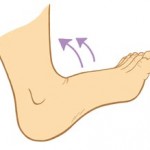 When you are sitting down, lift your toes up as high as you can towards your calf. This is called dorsiflexion. This is a great stretch to help with tight calf muscles and extensor tendons on the top of the foot. DO NOT use your hands to help pull your toes up further! This added pressure will cause damage to the plantar fascia!
When you are sitting down, lift your toes up as high as you can towards your calf. This is called dorsiflexion. This is a great stretch to help with tight calf muscles and extensor tendons on the top of the foot. DO NOT use your hands to help pull your toes up further! This added pressure will cause damage to the plantar fascia!
Rolling
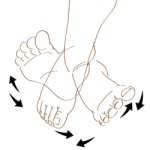 This is an exercise where you’re told to use a round object to massage the ligament by applying downward pressure. This WILL hurt your plantar fascia. The plantar fascia is like the string of a bow. It remains tight and straight, and no form of pressure is needed for the string to do its job. Any change in pressure on the string will cause the bow to work differently. No pressure should ever be put onto your plantar fascia.
This is an exercise where you’re told to use a round object to massage the ligament by applying downward pressure. This WILL hurt your plantar fascia. The plantar fascia is like the string of a bow. It remains tight and straight, and no form of pressure is needed for the string to do its job. Any change in pressure on the string will cause the bow to work differently. No pressure should ever be put onto your plantar fascia.
Calf Stretch
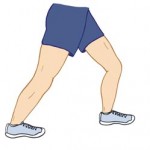 Place the leg to be stretched behind and lean forward, ensuring the heel is kept in contact with the floor at all times. Hold the stretch for 30 seconds and repeat three times. This can be repeated throughout the day and should not be painful. A stretch should be felt at the back of the lower leg. If not, then move the back leg further back. A more advanced version is to use a step and drop your heel down off of it. This more advanced version should not be attempted by anyone who has any pain from plantar fasciitis.
Place the leg to be stretched behind and lean forward, ensuring the heel is kept in contact with the floor at all times. Hold the stretch for 30 seconds and repeat three times. This can be repeated throughout the day and should not be painful. A stretch should be felt at the back of the lower leg. If not, then move the back leg further back. A more advanced version is to use a step and drop your heel down off of it. This more advanced version should not be attempted by anyone who has any pain from plantar fasciitis.
Soleus Stretch
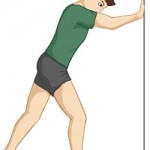 This is the same stretch as the calf stretch, with the exception that you’re leaning up against a wall. The forward motion will help stretch your calf muscles and your hamstring as well. To feel more of a stretch pull your front leg further down to the wall and bend down. The back leg should always be straight with your toes pointing.
This is the same stretch as the calf stretch, with the exception that you’re leaning up against a wall. The forward motion will help stretch your calf muscles and your hamstring as well. To feel more of a stretch pull your front leg further down to the wall and bend down. The back leg should always be straight with your toes pointing.
Stretching On A Step
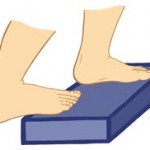 This stretch will cause injuries! When standing half on the step, the corner of the step is putting pressure on the plantar fascia. The more you let your heels go down the more pressure is applied and the more damage you are doing to your plantar fascia.
This stretch will cause injuries! When standing half on the step, the corner of the step is putting pressure on the plantar fascia. The more you let your heels go down the more pressure is applied and the more damage you are doing to your plantar fascia.